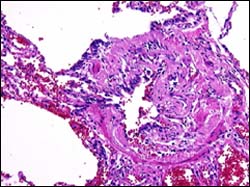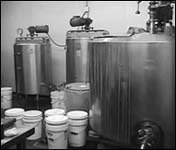What are the health effects of flavorings-related lung disease?
Exposure to certain airborne flavorings is associated with higher rates of respiratory symptoms such as cough, fatigue, and difficulty breathing with exertion or exercise. Studies have shown an association with occupational exposure to certain flavorings and the development of lung disease characterized by fixed airways obstruction. Some employees exposed to these flavorings have developed permanent lung damage including a rare disease called bronchiolitis obliterans.1,2
How is flavorings-related lung disease diagnosed?
Individuals with flavorings-related lung disease may have respiratory symptoms and/or abnormal spirometry findings of fixed airways obstruction. Spirometry is a test that evaluates lung function. Fixed airways obstruction is diagnosed when the person tested has difficulty blowing air out of the lungs (obstruction) and this difficulty does not improve with asthma medication, indicating a fixed obstruction.
Employees exposed to certain airborne flavorings may complain of respiratory symptoms such as cough, fatigue, and difficulty breathing with exertion. These symptoms may vary in range from mild to severe. Usually symptoms progress gradually, but in some cases severe symptoms can occur suddenly. The symptoms
usually do not get better when employees leave the workplace or go on vacation.1
What is the treatment for flavorings-related lung disease?
Employers and employees need to make sure that healthcare providers are aware of potential airborne exposures to flavorings in the workplace. The finding of fixed airways obstruction in an exposed employee, especially in a symptomatic individual, should be investigated for possible occupational lung disease, including bronchiolitis obliterans.
Healthcare providers should advise employees about workplace exposures that may possibly aggravate or worsen
existing lung disease. Recommendations and options for restricting employee exposure should be discussed.1
Affected employees may notice a gradual improvement in their cough after they
are removed from the flavoring exposure, but this may take years. Unfortunately, the shortness of breath with exertion often persists even after the cough has improved.
Patients with severe lung disease including bronchiolitis obliterans are usually treated with steroid medication,
although most have not experienced significant improvement of their illness with
this treatment. Patients with severe disease may require a lung transplant.
Can exposure to flavorings cause any other adverse health effects?
Employees may experience eye, nose, throat, and skin irritation after occupational exposure to certain flavorings. Chemical eye burns have also been noted. Additionally, there is some evidence that occupational asthma may be associated with workplace exposure to certain flavorings.1
What is bronchiolitis obliterans?
Bronchiolitis obliterans is a very rare lung disease that occurs when the smallest airways of the lung become inflamed and scarred, resulting in thickening and narrowing (obstruction) of the airways. This obstruction interferes with ventilation, the movement of air in the lungs.3

Normal lung
(Photo courtesy of Uniformed Services University of the Health Sciences) |

Small airway with obstruction
in bronchiolitis obliterans
(Photo used with permission from European Respiratory Society Journals4) |
How is bronchiolitis obliterans diagnosed?
 There are several diagnostic tools available to diagnose bronchiolitis obliterans. Spirometry is a test that evaluates lung function. Patients with bronchiolitis obliterans often have spirometry findings of fixed airways obstruction. Some patients also show restriction on spirometry which means that the lungs have decreased ability to expand. There are several diagnostic tools available to diagnose bronchiolitis obliterans. Spirometry is a test that evaluates lung function. Patients with bronchiolitis obliterans often have spirometry findings of fixed airways obstruction. Some patients also show restriction on spirometry which means that the lungs have decreased ability to expand.
Additional tests include chest x-rays which are often normal, but may show hyperinflation (too much air trapped in the lungs). Another imaging test, high resolution computerized tomography scans (CT or CAT scans) may also show airtrapping and thickening of the airway walls. If a biopsy or tissue sample of the lungs is performed, narrowing or complete obstruction of the small airways may be seen when the tissue is examined with a microscope.1,2,3
 What causes bronchiolitis obliterans? What causes bronchiolitis obliterans?
Bronchiolitis obliterans has been diagnosed in employees with occupational exposures to certain flavorings or certain irritant gasses such as ammonia, chlorine or sulfur dioxide. People who have had organ transplants or who have connective tissue disorders such as rheumatoid arthritis and lupus can develop bronchiolitis obliterans. Some respiratory infections caused by viruses/bacteria and certain medications are also associated with the development of bronchiolitis obliterans. Although many diseases or occupational exposures are associated with bronchiolitis obliterans, it is actually a rare disease.1,2,3
References
- Preventing
Lung Disease in Workers Who Use or Make Flavorings. US Department of
Health and Human Services (DHHS), National Institute for Occupational Safety
and Health (NIOSH) Publication No. 2004-110, (2003).
- Kreiss, K., et al. "Clinical bronchiolitis obliterans in workers at a microwave-popcorn plant". New England Journal of Medicine
347.5(2002): 330-338.
- Lazarus, S. Murray & Nadel's Textbook of Respiratory Medicine.
"Chapter 41: Disorders of Intrathoracic Airways".
4th ed. Saunders: Philadelphia, (2005): 1295-1310.
- Akpinar-Elci M., et al. "Bronchiolitis obliterans syndrome in popcorn
production plant workers". European Respiratory Journal 24(2004): 298-302.
|

